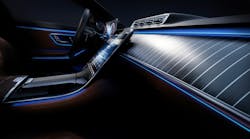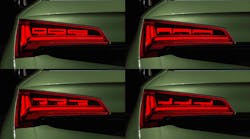However, the XEL-1 is ultra-slim, with the screen measuring only 3 mm at its thinnest point. The retail list price is 200,000 yen (approx. $1700).
Sony says that its "Organic Panel" used in XEL-1, which has been in production since September 2007, provides advantages such as high contrast, high peak brightness, good color reproduction and rapid response time.
Sony's move is seen as an attempt to plant a flag in the OLED TV market ahead of rivals such as Samsung and LG. Samsung demonstrated a 40-inch OLED TV over two years ago but has not moved the technology into production (see Samsung showcases first 40-inch OLED).
Sony says that the launch of XEL-1 represents "the first stage in Sony’s OLED TV business, and Sony will continue to advance its OLED TV development, while focusing on long-term business growth. Sony will also extend beyond its own OLED development and production, to leading the expansion of surrounding industries and the OLED market as a whole."
Sony first began researching organic materials in 1994, and in 2004 launched mass production of small sized, full-color OLED panels that have been used commercially in mobile products. The company then positioned OLED as a key next-generation display device, and further accelerated its R&D of OLED technology.
The Organic Panel used in the XEL-1 combines many aspects of technology. Since OLEDs are self-emissive and do not require backlights, the Organic Panel consists of several hundred nanometers of organic material, with very thin glass panels on either side. This enables the very thin form-factor of the TV.
The OLED display is capable of reproducing very deep black levels, with a contrast level of 1,000,000:1, and the output can be controlled from zero to peak brightness. The "Super Top Emission" technology developed by Sony allows for efficient light emission from the organic materials, enabling very high peak brightness.
Sony has developed its own proprietary organic materials that enable "excellent" color reproduction, particularly for natural colors, and this can be sustained in scenes of lower brightness.
Since the light emitted from the organic material layer can spontaneously be turned on and off, OLED technology is capable of very rapid response times. Newly developed OLED drive circuits enable “XEL-1” to reproduce fast moving images such as sports scenes smoothly and naturally.
And finally, if that weren't enough, the absence of a separate backlight means that OLED TVs consume extremely low levels of power compared with other display devices. The power consumption of XEL-1 is as low as 45W.






